This post covers a number of (mainly) bird related activities during January, February and March.
Apart from our week in France we’ve been having a relatively quiet time during the first three months of the year. I made a New Year’s Resolution to do some birding every single day and so far I have stuck to that, but I haven’t travelled outside of Dorset and West Hampshire (except to travel to Paris) but have done a fair bit of local birding within that area and a lot of bird ringing at our regular sites.
Also I haven’t taken many photos, often deliberately leaving my camera at home. This is because I still have photos to edit and reports to complete on trips I did in 2016, so it seemed pointless adding even more to the ‘to do’ pile.
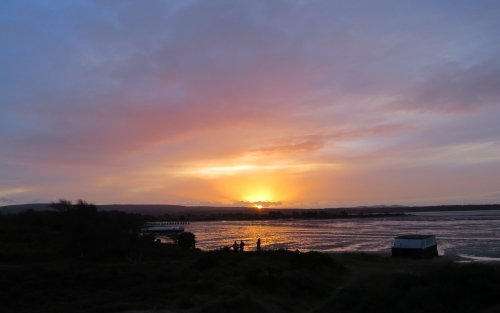
A sunset is usually placed at the end of set of slides not at the start, but early this winter these has been a sizeable roost of Starlings near Shell Bay at the entrance to Poole Harbour and so the sunset has to come first.

Many thousands of birds have come into roost, often performing the wonderful aerial acrobatics known as a ‘murmuration’. On this occasion the wind was rather strong and the flocks just flew in to roost.

I have birded many places in Dorset, mostly around Poole but sometimes going as far as Weymouth, Abbotsbury or the New Forest. On one particularly sunny day Margaret and I went back to Shell Bay.

For those who have never visited this is a particularly beautiful part of the Dorset coast. On the other side of the Bay is Sandbanks, one of the most expensive areas of the UK. The Haven Hotel and the chain ferry that permits vehicular access to the Studland peninsula can be seen.

Our target was this Snow Bunting which was feeding on the beach where Shell Bay meets Studland Bay. Although a regular wintering bird in reasonable numbers on the east coast, I have only seen this species seven times in Dorset, all singles except in early ’82 when a flock of 6-7 occurred in the Studland area.

As I said earlier I haven’t been taking my camera with me very much this year and these photos were hand-held digiscoped, hence the lack of quality.

Two races of Snow Bunting occur in Britain, nominate nivalis (from northern Europe and northern Canada) and the Icelandic insulae. All the evidence points to this being the nominate race.

The area around Mordon Bog and Sherford Bridge can be very good for birds but if you want to explore the area around Mordon Park Lake you need to cross this very dodgy ‘bridge’.
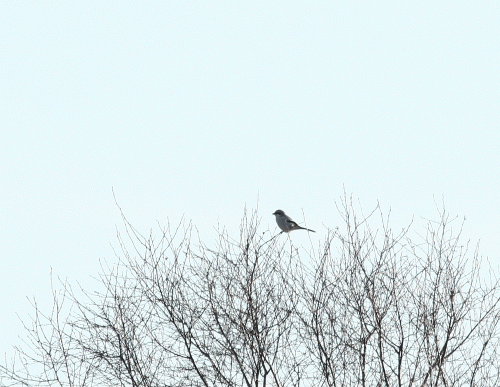
A distant Great Grey Shrike was the best bird I saw in Wareham Forest this year.

Leaving the birding scene behind for a moment, on one clear night I visited my friend and former work colleague Tim to look through his astronomical telescope. Unfortunately living in the middle of Poole, ambient lighting rather spoilt the images. No planets were in view but we did look at some star clusters and nebulae ….

…. but my favourite object that Tim was able to show me was galaxy M82, one of the Messier objects, 110 diffuse nebulae, planetary nebulae, open clusters, globular clusters and galaxies that were catalogued by Charles Messier as he searched the heavens for comets. Our view of galaxy M82 was nowhere near as good as this one (taken from Wikipedia) but it becomes the furthest object I have ever seen. At 12 million light years (or just over 100,000,000,000,000,000,000 km) the light would have left this galaxy in the Miocene era, even before human’s ape-like ancestors walked the earth.

I have done many trips in the UK and a few abroad with my friend Roger (here seen on a pelagic trip in the Azores) ….
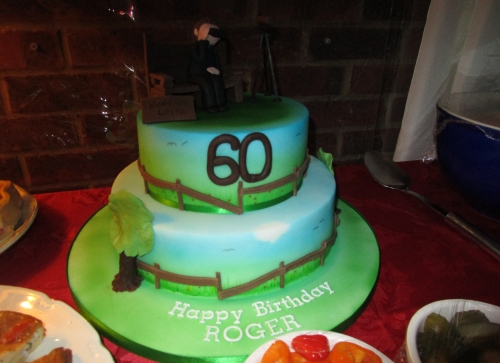
…. so it was very pleasing to be able to attend his 60th birthday party. This unusual cake (made by his wife Sue) is complete with a model of Roger birding from a park bench.

Although I have I have little or no interest in gardening it’s probably Margaret’s favourite occupation. Deciding the front path was getting a bit grubby she bought a power washer and before I was even aware what was going on she had cleaned the lot.

Though she looked like she had a bad case of measles when she had finished.
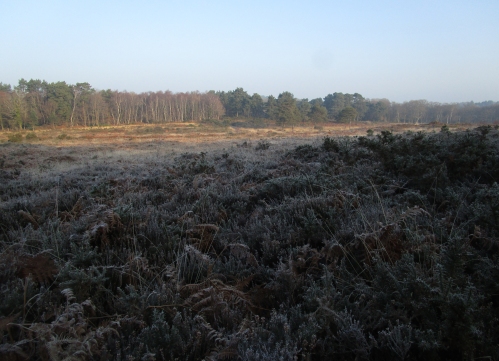
Most of my activities during this period have involved bird ringing which I have been keen to continue through the winter period. This winter we have started ringing at a new site on heathland to the north of Poole which has proved very productive, especially for finches. This is the view on a frosty morning from our ringing site.

Here are a few photos of birds in the hand: I don’t think I’ve ever seen a Blackbird with such incredibly rich colour to the bill and eye-ring before.

Understanding and recognising moult is key to telling the age of a bird and telling the age of a bird is key to understanding population dynamics. But there are always exceptions to the rule. This Robin has just moulted its three innermost primaries but not the rest. This is not a usual moult strategy and might have occurred after the feathers were lost after an attack by a predator.

Goldcrests can be aged by the shape of the tail feather, pointed in first years, rounded in adults. This first year Goldcrest has lost the three outer tail feathers on the right-hand side and although obviously it is still in its first year it has regrown the feathers with an adult shape. Thus if the bird was to loose all its tail feathers and regrow them in the shape of an adult, it would be incorrectly aged.

Some birds can be easily sexed in the field (for example Chaffinch or Bullfinch), other can only be reliably sexed in the hand such as this Greenfinch. The diagonal shape of the yellow on the outer webs of the inner primaries shows that this is a male. On a female the yellow would run parallel to the shaft leaving a black streak between the yellow and the shaft for the entire length of the feather.

Goldfinches can be only aged on the combination of a number of features and then only reliably in adult birds. The red extending behind the eye, more extensive red chin and longer bill indicate that the bird in the foreground is a male. Although on average, the male is slightly larger than the female, this is exaggerated in this photo as it is being held nearer to the camera.

We usually catch a few Redpolls in the autumn on migration at Durlston but its a long time since I’ve ringed one in it’s its breeding finery. We have caught a Redpoll that was ringed elsewhere and look forwards to learning where it came from and when it was ringed.
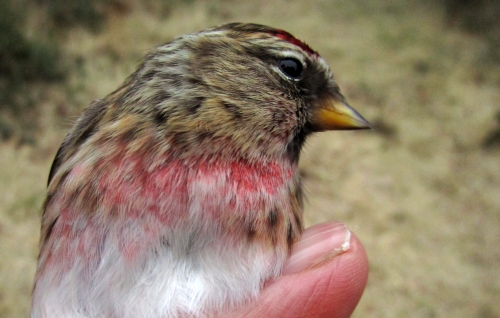
Redpolls are comprised of 5 or 6 subspecies divided into 3 (BOU list) or two (IOC list) species. The BOU has stated that as from the start of 2018 it will follow the IOC checklist, so we will loose our breeding form Lesser Redpoll as a separate species as it will be lumped with Common Redpoll. This however is just the start of the story, recent genetic research has shown that all the races of Redpoll are genetically identical and a proposal is being considered to lump the lot, so we will go from having three species on the British list to just one.

Another bird that we usually only ring in the autumn is Pied Wagtail when the majority are in drab first-year plumage. This smart male was ringed in one of our group member’s garden close to Lytchett Bay.

Another species we only ring occasionally is Jay, an aggressive and noisy bird in the hand and one that will leave deep marks on your fingers if they get anywhere near its bill. We have ringed four recently at our new site, it would be nice to get a recovery.

One of the ongoing puzzles that ringing may solve is the issue of ‘Siberian’ Chiffchaffs. This bird seen and ringed at one of our sites in Poole calls and sings like a Siberian (race tristis) has the whitish belly and green fringes to the flight feathers, yet in certain lights shows greenish tones in the upperparts. Body feathers accidentally shed in the ringing process have been sent for DNA analysis but as only mitochondrial DNA markers are available this will merely tell us what its mother was! Tristis is increasingly being touted as a full species, based mainly on its unique vocalisations, so robust identification criteria are needed.

Over the last few months I have been ringing with a young lady named Fenja. She recently returned from a voluntary research expedition to the lowland rainforest of south-east Peru where she assisted in wildlife censuses and ringing. During her stay they trapped 32 species of rainforest birds, all but one have been seen by me in one place or another, but I am quite envious of the photos of her holding a Hairy-crested Antbird, a species I have never even seen.

Towards the end of March our ringing group held its AGM, this time in a more professional looking location than my conservatory. As always it took ages to work through the agenda because we kept getting side-tracked (but some of us expected that and brought some beer along). L-R: Shaun Robson, Andy Welch, Olly Slessor, Ginny Carvisiglia, me, Chris Minvalla, Mike Gould, Daniel Whitelegg, Paul Morton, Carol Greig, Sean Walls, Bob Gifford and Brian Cresswell. Out of shot are Ian Alexander, Kath Clay and Terry Elborn. We thank Brian and Sean for allowing us to use the Biotrack offices for the meeting.

At the end of every AGM Bob awards the so-called ‘Stoate Award’ for the worst data submission in the last year. This time he performed it in the manner of the Oscars, calling on Shaun to open the envelope and read out the ‘winner’, then declaring a mistake had been made and then having it read out again. As expected I was the recipient, but I pointed out that I entered 64% of all the data submitted last year and therefore more mistakes were to be expected. The actual award is an unidentifiable ornamental bird, I’d rather it was the stuffed Eagle Owl in corner of the photo.

However the worse sin was that occasionally, when the program rejected a bird’s biometrics on the basis of it being too heavy, I would type ‘fat bastard’ or ‘who ate all the pies’ in the comments box. Judging from the photo above I think that’s a case of ‘the pot calling the kettle black’!